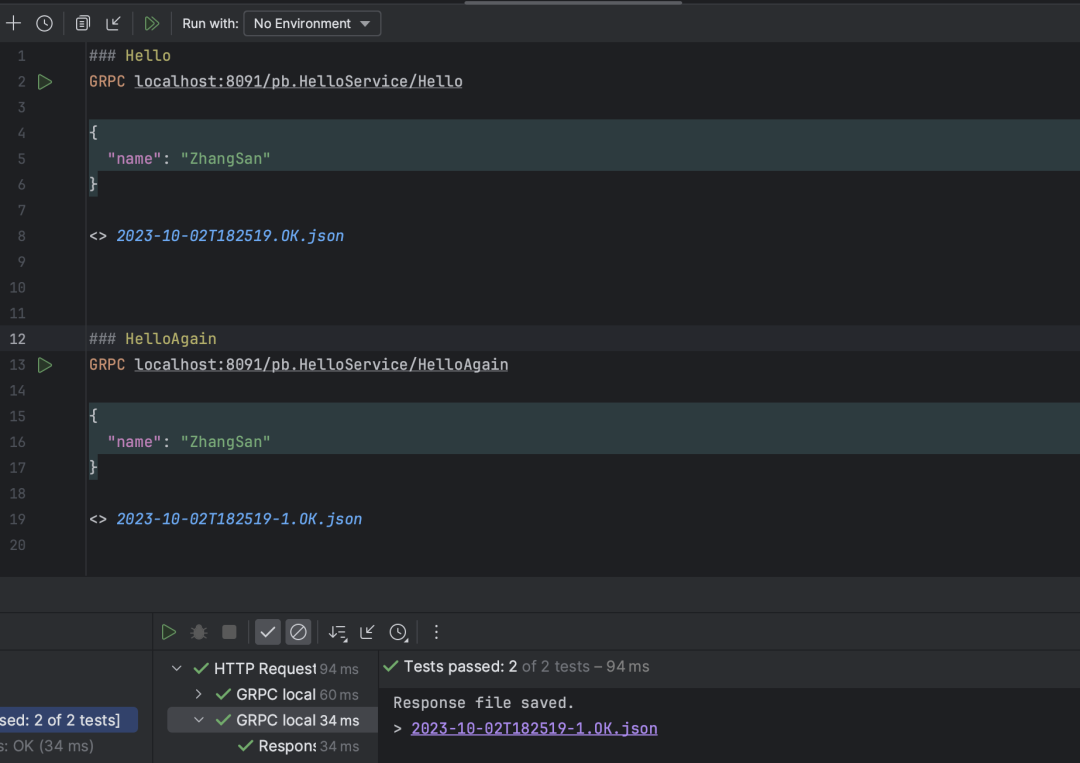

使用go语言实现一个grpc拦截器
描述
在开发grpc服务时,我们经常会遇到一些通用的需求,比如:日志、链路追踪、鉴权等。这些需求可以通过grpc拦截器来实现。本文使用go语言来实现一个 grpc一元模式(Unary)拦截器,上报链路追踪信息。
原始类型定义
我们可以在grpc的源码包里(interceptor.go),找到一元模式拦截器的类型定义:
// UnaryServerInterceptor provides a hook to intercept the execution of a unary RPC on the server. info // contains all the information of this RPC the interceptor can operate on. And handler is the wrapper // of the service method implementation. It is the responsibility of the interceptor to invoke handler // to complete the RPC. type UnaryServerInterceptor func(ctx context.Context, req any, info *UnaryServerInfo, handler UnaryHandler) (resp any, err error)
从上面的定义可以看出,一元模式拦截器是一个函数,接收四个参数,返回两个参数。下面我们来看一下这四个参数的含义:
ctx:上下文对象。
req:请求参数
info:包含了RPC的元信息,比如服务名、方法名等。
handler 实例的方法,用来调用实际的RPC方法。
我们只需要实现一个上述类型的函数,在里面实现我们的功能,然后再执行handler函数,就可以实现一个拦截器了。
实现拦截器
我们新建一个项目grpcdemo。
服务定义
我们先在项目目录下新建一个proto文件,定义一个服务:
hello.proto
定义一个Makefile:
protos: protoc --proto_path=./ --go_out=pb --go-grpc_out=pb --go_opt=paths=source_relative --go-grpc_opt=paths=source_relative ./*.proto tidy: go mod tidy run: go mod tidy go run main.go
执行以下命令,生成go代码:
make protos
代码开发
第一步,新建一个tracing.go,初始化链路追踪器:
tracing.go
第二步,在main.go文件中,添加相关代码:
main.go
在上面的代码中,我们启动了一个grpc服务,监听8091端口。在启动grpc服务前,初始化了链路追踪信息,然后在grpc服务中,使用了自定义的拦截器。在自定义拦截器中,我们上报了链路追踪信息。
启动jaeger服务
具体的启动方式,可以参考官方文档:www.jaegertracing.io/docs/1.26/g…
测试
我们使用goland的grpc插件,来测试一下:
#
GRPC localhost:8091/pb.HelloService/Hello
{
"name": "ZhangSan"
}
#
GRPC localhost:8091/pb.HelloService/HelloAgain
{
"name": "ZhangSan"
}
测试结果:

我们再打开jaeger的UI,查看链路追踪信息:

可以看到,我们的链路追踪信息已经上报到了jaeger服务。
审核编辑:汤梓红
-
如何运用Go语言实现人脸识别2018-08-23 13519
-
介绍一个C语言实现的http下载器2023-02-22 736
-
GRPC的基础使用方法2023-09-19 1734
-
HarmonyOS实战开发-如何在Navigation中完成路由拦截2024-05-08 434
-
基于Proteus和C语言实现2021-07-14 943
-
动能拦截器六自由度仿真建模研究2009-08-07 744
-
springmvc 自定义拦截器实现未登录用户的拦截2017-11-25 3335
-
4个重要算法C语言实现源代码2018-06-10 1787
-
如何使用C语言实现一个比较简单的猜数游戏的程序免费下载2019-04-24 940
-
使用C语言实现压缩目录每一个文件为一个单独的zip文件程序免费下载2019-11-01 1207
-
go语言实现的简单im即时通信系统2021-10-20 4179
-
go语言实现的简单im即时通信系统解析2021-10-26 5204
-
一个使用Java语言实现的向量化BLAS库VectorBLAS2023-08-16 2235
-
springboot过滤器和拦截器哪个先执行2023-12-03 3309
-
Spring拦截器:你的请求休想逃过我的五指山!2025-07-26 570
全部0条评论

快来发表一下你的评论吧 !

